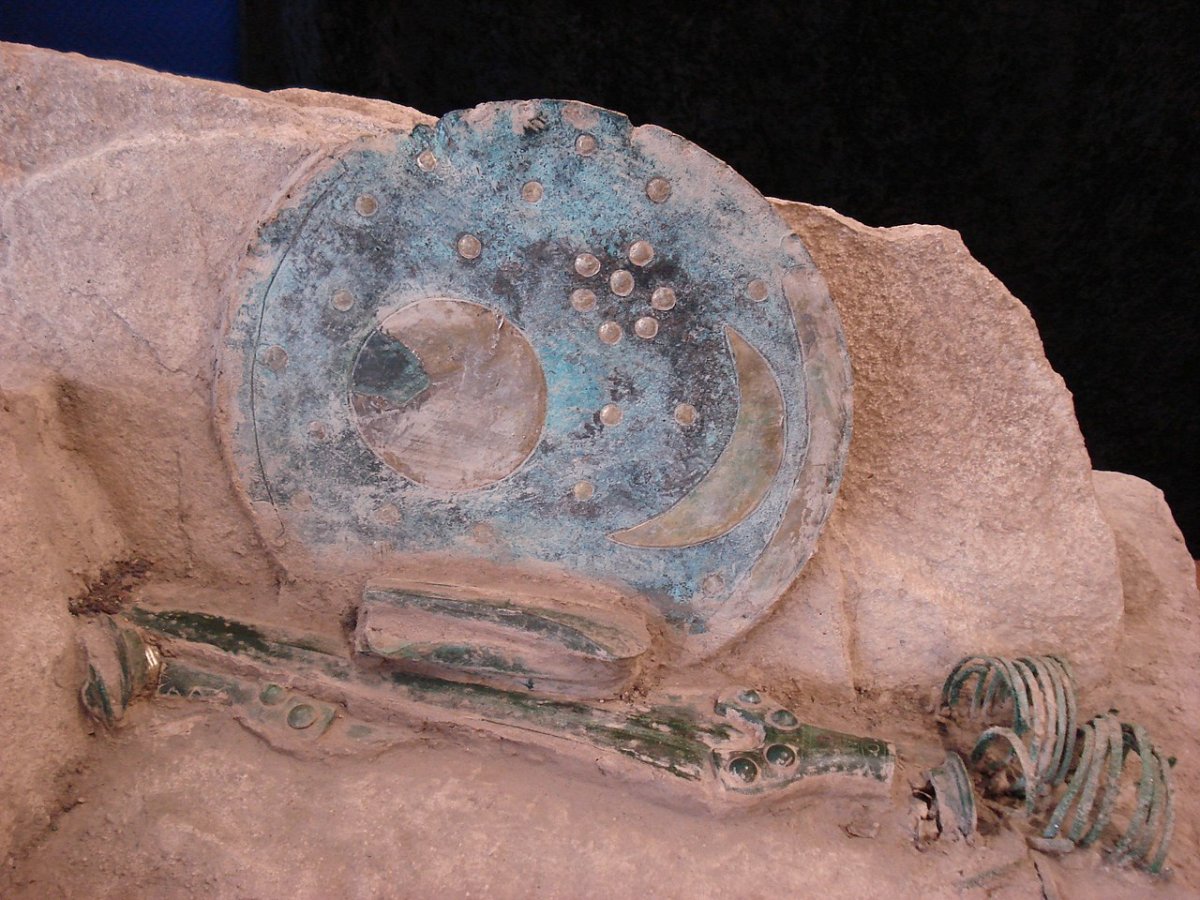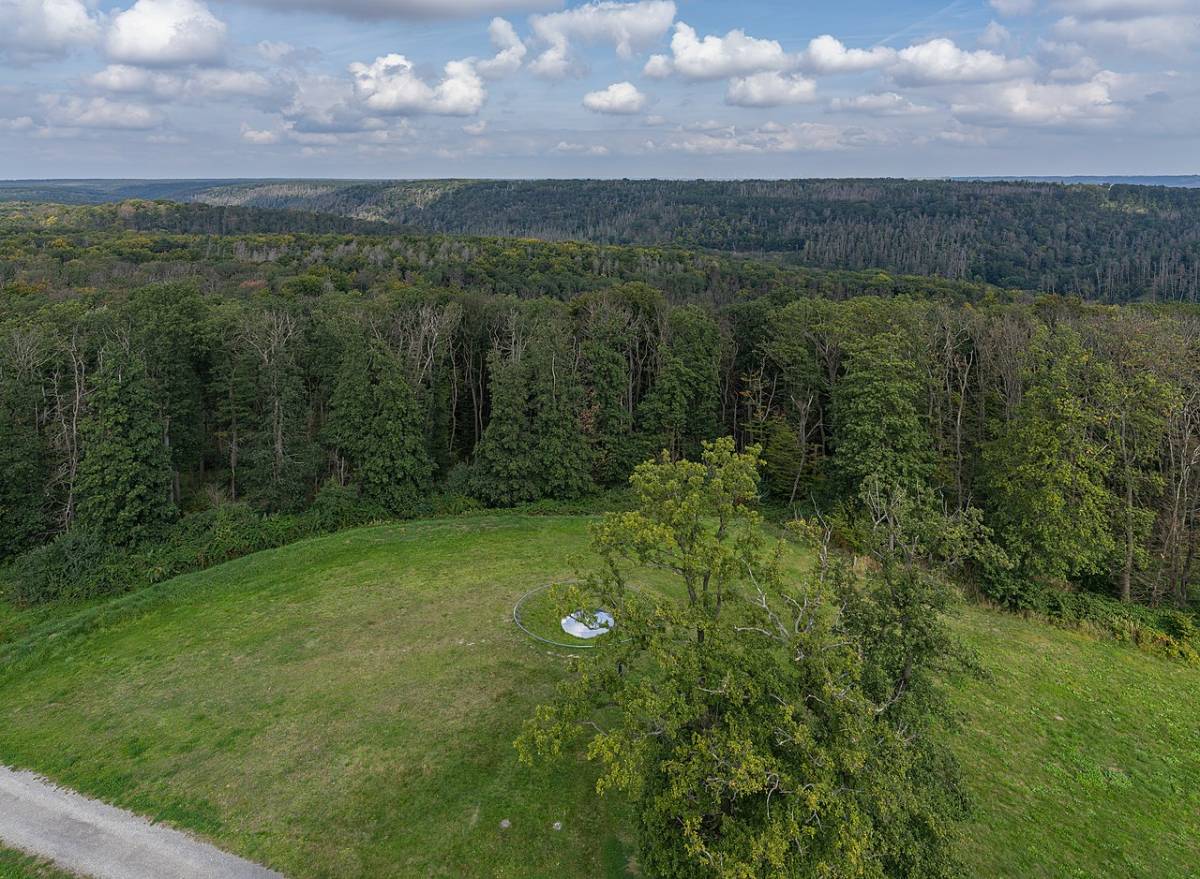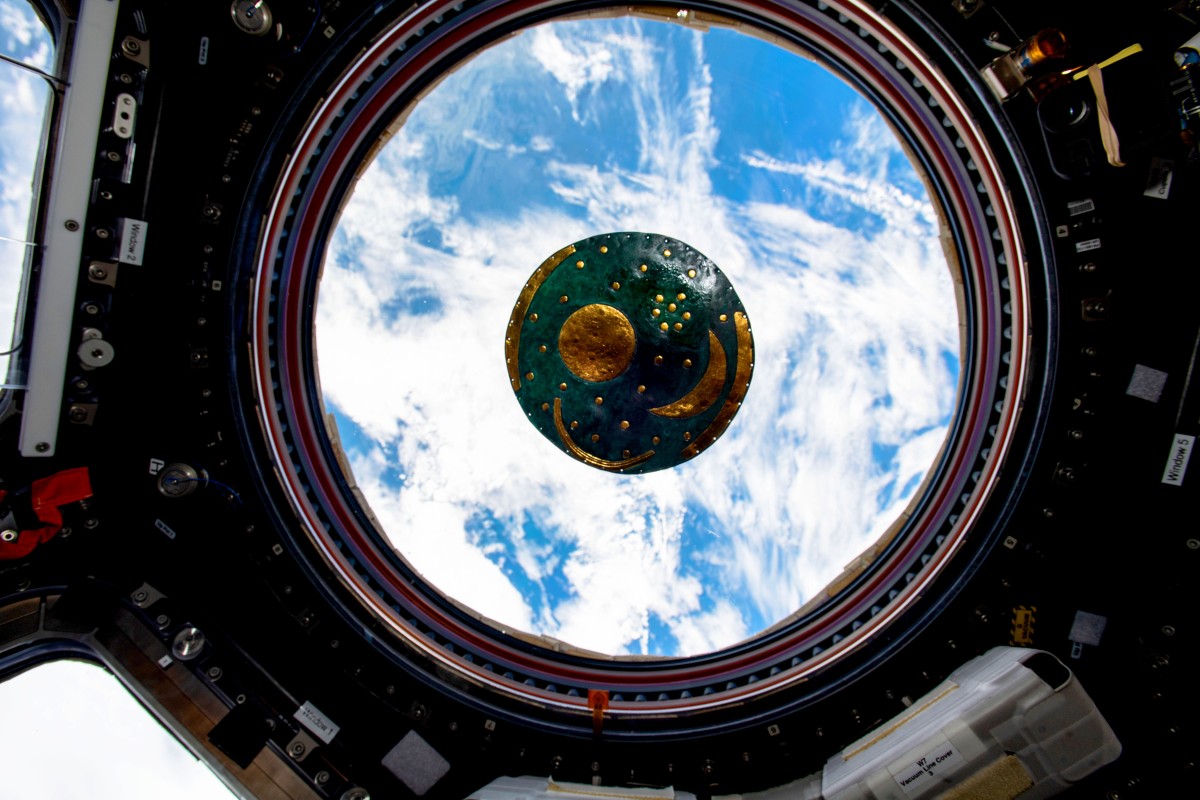A masterpiece of astronomy and art from prehistoric times.
The Nebra Sky Disc is a remarkable artefact that has fascinated archaeologists, astronomers, and the public alike. It is a bronze disc of about 30 cm in diameter, decorated with gold symbols that represent the Sun, the Moon, the stars, and other celestial phenomena. It is widely regarded as the oldest concrete depiction of astronomical knowledge in the world, dating back to about 1600 BCE. But how was it made, who used it, and what does it tell us about the beliefs and culture of the people who created it?
The Nebra Sky Disc was discovered in 1999 by two treasure hunters who were illegally using a metal detector on the Mittelberg hill near Nebra, Germany. They dug up the disc along with two bronze swords, two axe heads, a chisel, and spiral arm rings. They damaged the disc with their spade and removed some of the gold ornaments. The next day, they sold the whole hoard to a dealer for 31,000 DM (about 15,800 euros).
 Replica of the find situation of the Nebra Sky Disc for the German exhibition Der geschmiedete Himmel (German “The forged sky”). Photo: Christian Reinboth
Replica of the find situation of the Nebra Sky Disc for the German exhibition Der geschmiedete Himmel (German “The forged sky”). Photo: Christian Reinboth
The disc and the other objects changed hands several times in the black market, until in February 2002 state archaeologist Harald Meller obtained it through a police sting operation in Basel after a couple attempted to sell it on the black market for 700,000 DM.
 Reconstruction of the objects, including the sky disc, found at the site. Photo: Drekamu
Reconstruction of the objects, including the sky disc, found at the site. Photo: Drekamu
The original finders were traced and sentenced to prison for looting and damaging cultural heritage. They later led the police and archaeologists to the exact spot where they found the disc, where further excavations confirmed its authenticity and revealed more clues about its context.
The discovery site is located in the Ziegelroda Forest, known as Mittelberg (“central hill”), some 60 kilometres (37 mi) west of Leipzig. It is a prehistoric enclosure encircling the top of a 252 metres (827 ft) elevation in the forest, which is known to have been settled in the Neolithic era.
 View of site where the Nebra Sky Disk was discovered, with the exact spot marked. Photo: PantheraLeo1359531
View of site where the Nebra Sky Disk was discovered, with the exact spot marked. Photo: PantheraLeo1359531
The Nebra Sky Disc is a masterpiece of Bronze Age craftsmanship and astronomy. It is made of bronze alloyed with a small amount of tin, which gives it a blue-green colour. The gold symbols are made of thin sheets of gold leaf that were cut and pressed into the bronze surface. The disc has a slightly convex shape and a raised rim.
The gold symbols on the disc are interpreted as follows:
- A large circle at the centre, representing either the Sun or the full Moon
- A smaller crescent at the right edge, representing either the new Moon or a lunar eclipse
- 32 small dots around the rim, representing stars
- A cluster of seven dots near the centre, representing the Pleiades star cluster
- Two curved lines along the sides, representing the angle between the summer and winter solstices
- A curved line at the bottom with parallel lines inside, representing either a solar boat with oars, a rainbow, an aurora borealis, a comet, or a sickle
 Nebra Sky Disc, marking the summer and winter solstices. Image: Frank Vincentz
Nebra Sky Disc, marking the summer and winter solstices. Image: Frank Vincentz
The disc is thought to have been used as a calendar or an astronomical instrument to track the movements of the Sun and Moon and to predict eclipses and solstices.
It may have also had religious or ritual significance, as it reflects a cosmology that places the Sun at the centre of creation and associates it with life, fertility, and power.
The disc also shows that the people who made it had contact with other cultures across Europe and beyond. The bronze used for the disc came from ore mined in central Europe, while the gold came from Cornwall in Britain or Transylvania in Romania. The style of the swords and axes found with the disc is typical of the Unetice culture, which spanned from central Germany to Poland and Czechia. The spiral arm rings are similar to those found in Scandinavia and Ireland. The depiction of the Pleiades star cluster is also found in ancient cultures from Mesopotamia to Greece.
 Nebra skydisc, position of the arcs at evening of winter solstice. Image: Rainer Zenz
Nebra skydisc, position of the arcs at evening of winter solstice. Image: Rainer Zenz
Despite its fame and importance, many questions remain unanswered about the Nebra Sky Disc. For example:
- Who made it and for what purpose?
- How was it used and by whom?
- How accurate was it as an astronomical device?
- How did it end up on the Mittelberg hill?
- Was it part of a larger hoard or a ritual deposit?
- Why was it buried and when?
- How did it survive for over 3,000 years without being corroded or destroyed?
Some scholars have also challenged its authenticity and dating, arguing that it is a modern forgery or that it belongs to a later period than previously thought.
However, most experts agree that it is genuine and that it dates to around 1600 BCE based on scientific analyses of its materials, style, context, and astronomical features.
 A replica of the Nebra Sky Disc in the seven-windowed Cupola of the International Space Station, posted on social media by astronaut Matthias Maurer in March 2022 with the caption: “Like a mini version, my Cosmic Kiss mission patch floats here next to the Nebra Sky Disc (at least a copy of it) in the Cupola of the International Space Station. In the background, a breathtaking view of our Earth. The more my mission progresses, and the more incredible experiences I get to live up here, the more connected I feel to the message of my #CosmicKiss mission – the declaration of love for space. Inspired by the 3600 year old Sky Disc my Cosmic Kiss patch represents the special connection that the Space Station creates between the inhabitants of Earth and the cosmos, as well as the partnership we need to explore farther in in space.” Photo: NASA/ESA-M.Maurer
A replica of the Nebra Sky Disc in the seven-windowed Cupola of the International Space Station, posted on social media by astronaut Matthias Maurer in March 2022 with the caption: “Like a mini version, my Cosmic Kiss mission patch floats here next to the Nebra Sky Disc (at least a copy of it) in the Cupola of the International Space Station. In the background, a breathtaking view of our Earth. The more my mission progresses, and the more incredible experiences I get to live up here, the more connected I feel to the message of my #CosmicKiss mission – the declaration of love for space. Inspired by the 3600 year old Sky Disc my Cosmic Kiss patch represents the special connection that the Space Station creates between the inhabitants of Earth and the cosmos, as well as the partnership we need to explore farther in in space.” Photo: NASA/ESA-M.Maurer
The Nebra Sky Disc is currently exhibited at the State Museum of Prehistory in Halle, Germany. It has also been loaned to other museums around the world for special exhibitions. In 2013, it was inscribed on UNESCO’s Memory of the World Register as one of the most important archaeological finds of the 20th century.
Sources: 1, 2, 3